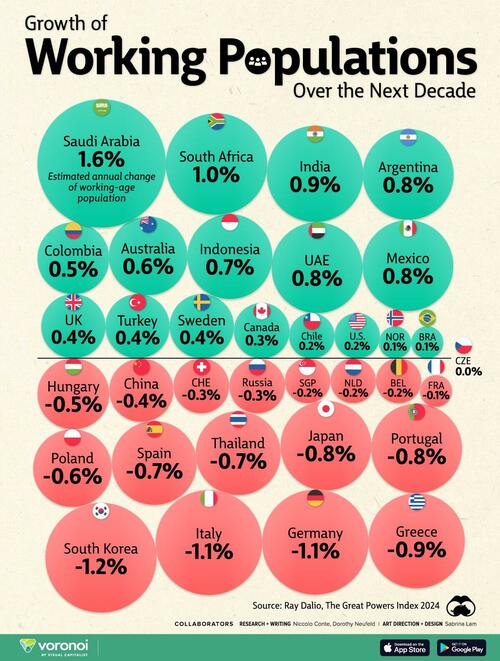
Posted on 09/24/2024 7:32:47 PM PDT by SeekAndFind
Today, the working age population in almost half of U.S. metropolitan areas has declined due to demographic shifts, and this trend is set to continue.
As a result, the U.S. workforce is projected to grow at just 0.2% annually over the next decade, roughly a quarter of the rate of markets like India and Mexico. Given the low birth rates and aging populations across many advanced economies, the world’s workforce is set to change significantly, with implications for economic and productivity growth.
This graphic, via Visual Capitalist's Dorothy Neufeld, shows the projected growth in major economies’ working age population, based on analysis from Ray Dalio’s Great Powers Index 2024.
Here are the estimated annual changes in the working age population across 35 countries over the next decade:
Saudi Arabia is projected to see the fastest-growing workforce across major economies, driven by high fertility rates of 2.8 children per woman and a rising expatriate population.
India, ranking in third, is set to contribute 24.3% of the world’s workforce over the next decade. With a current median age of 28.4, its working age population is expected to surpass one billion by 2030. These factors provide a significant competitive edge, especially in the services and manufacturing sectors, while also driving increased consumption among younger generations in the world’s most populous country.
Largely due to falling birth rates, the U.S. ranks 15th overall in the 35 countries on the list. In fact, America saw the slowest decade of population growth between 2010 and 2020 since the Great Depression, growing by 7.4%. For perspective, the U.S. population grew at nearly double this rate during the 1990s.
At the other end of the spectrum, South Korea ranks in last, with its workforce projected to see an annualized growth rate of -1.2% over the next 10 years. South Korea has the lowest fertility rate worldwide along with restrictive immigration policies, which are straining working age population growth and productivity.
Overall, 49% of major economies are projected to see declining working age populations, particularly across European nations and countries in Asia including China, Japan, and Thailand.
To learn more about this topic from an asset class perspective, check out this graphic on 10-year asset class return forecasts.
I swear, aren’t we smart enough to move toward an economy that functions well, with stable jobs and employment rates, without relying upon a constantly increasing population to consume more?. Are suburbs and housing starts the only way forward? Surely not.
You would think that such a path would be a topic of conversation, right? But instead we just panic and import aliens.
Disclaimer: Opinions posted on Free Republic are those of the individual posters and do not necessarily represent the opinion of Free Republic or its management. All materials posted herein are protected by copyright law and the exemption for fair use of copyrighted works.